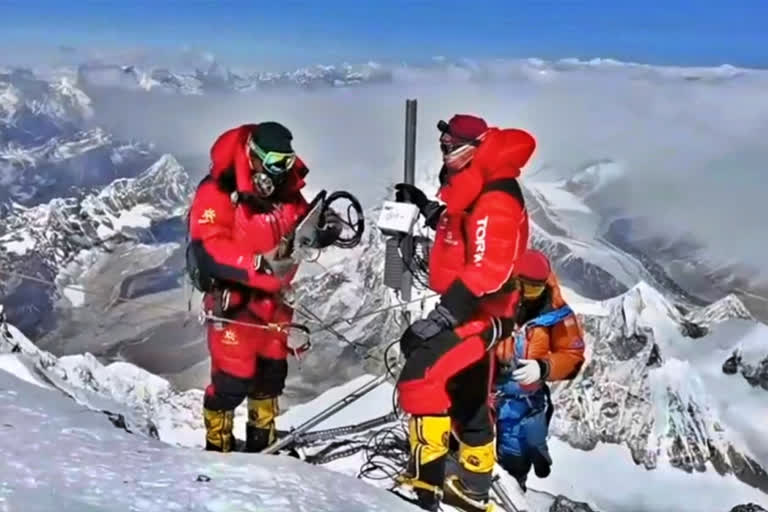New Delhi: The new world order-changing battle-lines are being drawn at the most unlikely of places. This time the scene of the battle is the region in the vicinity of the 8,848-metre-high Mount Everest, the world’s highest point, near the international border between China and Nepal.
On Wednesday (May 4, 2022), a 13-member team of Chinese expedition team comprising scientists and researchers from the Tibetan Plateau Research (ITP), under the Chinese Academy of Sciences (CAS), set up a station weighing about 50 kg of equipment at 8,800 meters just beneath the northern side of the peak.
In the process, the new scientific station has snatched away the record of the world’s highest observatory from a station set up in 2019 by a combined team of American and British scientists on the southern face of Mount Everest that was established at 8,430 meters. The latest station is the eight of a series of such installations under a project called ‘Earth Summit Mission 2022’ that has been set up by China on the northern side of the peak.
Chinese state-controlled media quoted Zhao Huabiao, a ITP researcher, as saying that, besides studying the high-altitude weather, the stations will also focus on the phenomena of melting of glaciers and also look inside the ground besides measuring the thickness of snow and ice. Earlier this year, three stations were set up at heights of 7,028 meters, 7,790 meters and 8,300 meters. In 2021, four stations were set up at heights of 6,500 meters, 5,800 meters, 5,400 meters and 5,200 meters. The development acquires significance in the backdrop of a major discovery of lithium deposit in the Mount Everest region that, according to the Chinese Journal of Science, could yield up to about 10,12,500 tons on a “conservative estimate”.
Besides its use in the batteries of laptops and cell phones, lithium is the core material in making electric vehicles (EV) batteries. The value of lithium can be gauged by the fact that the world is on the verge of an EV revolution. The first detail of the finding was published in the CAS-supported journal ‘Rock’ in November 2021. In February 2022, it was again reported by a team of scientists from the Institute of Geology and Geophysics under CAS.
Tests conducted by the Australasia Mineral Laboratory and Wuhan Upper spectra Analysis Technology Limited and repeated at the Geological Earth Institute Laboratory of the Central Academy also corroborated the initial findings after a sample study of 59 rock samples mined from the Tibetan region just north of Mount Everest, with 44 samples showing very high content the world’s highest peak by the Chinese Academy of Sciences (CAS) has revealed very rich lithium presence.
While any lithium oxide content more than 0.8 per cent is considered to be of industrial value, the lithium content in the said study was found to be much in excess with some samples reaching 3.3 per cent, with the mean lithium oxide content at 1.30 per cent. Also known as ‘white oil’, the rare earth was discovered in high altitude areas ranging from 5,390 metres to 5,581 metres in more than 40 lithium quartz crystal belts ranging from 10 metres to nearly 100 metres in width, about a km in length, and forming four rock pulsations and four mineral belts.
While China is dependent on imports for about 75 per cent of its lithium requirement and produces nearly two-thirds of the world’s lithium-ion batteries, it is believed that China covets this rare earth resource more to achieve its aim of geopolitical dominance and as leverage for use against the West rather than the commercial value.
Also read: India is completely reliant on China for its Lithium needs, reveals govt data



